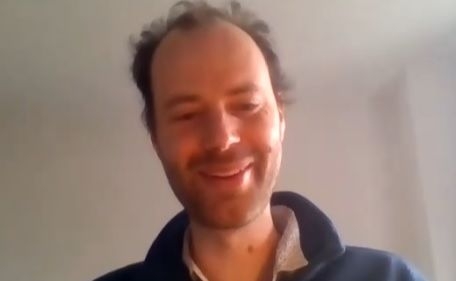News

Fourth RILEM Young members' interview
Dr Ruben Snellings is a Senior Researcher in Upcycling of Residues in Sustainable Binders at VITO, Belgium. Dr Snellings joined RILEM in 2011. He is currently the Deputy-Chair of RILEM TC 267-TRM, Tests for reactivity of supplementary cementitious materials.
RIM: Thank you, Ruben, for your time today. Let’s start from the beginning… where were you in 2011 when you joined RILEM?
R. Snellings: 2011 was the final year of my PhD and I was making plans for what to do afterwards. I was looking at several options and one of those was to work for a limited amount of time in the University of Ghent with Prof. Nele de Belie. At the same time, I was developing some contacts in Switzerland to start working there in 2012. In that period, Prof. Nele de Belie was starting a new RILEM Technical Committee on SCM (Supplementary Cementitious Materials). Since I have done my PhD on a very similar topic, she invited me to join that TC (editor’s note: 238-SCM Hydration and microstructure of concrete with supplementary cementitious materials). I ended up working with lots of very nice people in several working groups. I was, for instance, with Dr Barbara Lothenbach and we were running one of the working groups on the reaction products of SCM in concrete. I was also a bit involved in the other working groups dealing with characterisation, hydration and reaction kinetics, and concrete properties.
RIM: This means that when you joined RILEM you were a recently graduated PhD, am I right?
R. Snellings: Yes! I think I had the first meeting in Madrid at the ICCC conference where I got to know all of these people. It was really nice as before I was just reading their papers and now I could meet them in person, sitting around the same table. I got to know who they are, how they act in these committees. They were presenting their work and their recent findings, so it was really an eye-opener for me to be in such a committee. It was also a “big” committee (editor’s note: 47 members) so it was a nice way to networking.
RIM: Was it a little bit intimidating or you didn’t feel intimidated at all?
R. Snellings: Well… I guess that at the very first meeting, I was keeping myself more on the background just to get to know the people, and to understand the process of RILEM as I had no experience at all. How does this work? How do people communicate? What is the relationship between the TC members and TC Chair? But people were very nice immediately and open to connect and talk to you.
RIM: What happened then? It seems that you enjoyed your first RILEM TC as the RILEM database tells me that you have been a member of several more RILEM TCs.
R. Snellings: Yes! In the first 3-4 years I was only working in TC 238-SCM but that was a very active TC, very well managed with lots of TC meetings, papers, reviews, experimental work that I personally organised. So, that was taking quite a lot of my time. Then the TC ended and the following TC on this topic was TC CCC (editor’s note: 281-CCC Carbonation of concrete with supplementary cementitious materials). There I took a less intensive role as I was “just a member”. That TC focused more on the durability issue of the system. A topic that was not addressed in that TC was the reactivity and the reactivity assessment of SCM. That was very close to the work I was doing before and in those years too. We wanted to make a comparison of different methods that were out there, to see if we could propose a new method that could work better for a larger range of materials. This is actually the topic of the TC I am currently co-chairing with Prof. Karen Scrivener (editor’s note: 267-TRM Tests for reactivity of supplementary cementitious materials). We developed the proposal together and the TC officially started in 2015.
RIM: It seems that the establishment of TC 267-TRM was a very natural and fluid process. How did it work?
R. Snellings: In one of the meetings of TC 238-SCM it was obvious that there was a blind spot. Basically Prof Scrivener grabbed me by the arm and said “We should do something around this”, and then we started to write the proposal and it went quite fast.
RIM: TC 267-TRM started in 2015. How old were you, then?
R. Snellings: I was 30. That’s not very old…
RIM: The year after you received the RILEM Colonnetti medal. How was the submission process?
R. Snellings: 2016 was the first year in which the Colonnetti medal was offered. Maybe I was a little bit lucky as it was the first time and not that many people knew about it. The other medal (editor’s note: RILEM offers two Colonnetti medals every year) went to Prof. Susan Bernal that year so I was in good company. I applied thinking “Why not? Let’s try!”.
RIM: You are also an associate Editor of RILEM Technical Letters (RTL), whose papers are mainly (but not only) invited by the Editorial Board rather than spontaneously submitted. Would you like to tell us more about this role?
R. Snellings: It is a little bit different compared to what is done in other journals when papers come your way. In this case, to some extent, there is a bit of that also in RTL because in some occasions, like for instance the RILEM Annual Weeks, some contributions are selected during the event and these are then allocated to the editors. This can happen from time to time. In this way, letters come to you. But the invited papers are very important too, you need to think well about who to invite,. You have to think about your field, who has been very active, what can be of interest for the wider community. As an editor, you have to reach out for people and motivate them to write but, at least for me, this has never been an issue, I mean “motivating people to write for RTL” as most of them see this as a nice opportunity to expose their work.
RIM: You seem to know RILEM very well. How would you describe the relationship between RILEM and your career?
R. Snellings: I do think RILEM is probably the only platform where experts of construction, building materials and structures come together so frequently and work together on common topics. As far as I know, from other scientific disciplines, this is not that common. Of course, you have international Unions of different types, but they have usually a much more limited scope of work. RILEM is also a bottom-up system where any RILEM member can come up with a topic and form a group to work together. This structure is quite motivating and interesting. Also, the fact that RILEM is so international makes it a nice platform to communicate. I think it is one of the places to be in for people working in this field.
RIM: After so many years in RILEM, is there someone that you would describe as a good friend or mentor that you met through RILEM?
R. Snellings: I would say Luca Valentini from the University of Padova. I met him for the first time when I did my post-doc at EPFL, Switzerland. We worked together in CCL (editor’s note: 282-CCL Calcined Clays as Supplementary Cementitious Materials) and now we are in the process of making a special issue on cement and concrete for Elements Magazine. I Also Doug Hooton is a key person that I met through RILEM. We worked together in TC SCM and in TRM. Through him we managed to publish a new ASTM standardized test method (editor’s note: TC 267-TRM: Tests for reactivity of supplementary cementitious materials TC has developed a new test method, adopted by ASTM in 2020 as “ASTM C1897-20, Standard Test Methods for Measuring the Reactivity of Supplementary Cementitious Materials by Isothermal Calorimetry and Bound Water Measurements”). He is really one of the people I would go to, to discuss these topics.
RIM: Thank you again for sharing your thoughts and experience with us today!
R. Snellings: Thank you as well for this opportunity. I am always willing to share my views and insights into the work of the RILEM Technical Committees. And I do hope that these chats can happen again next year in person!














No comment
Log in to post comment. Log in.